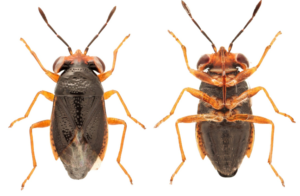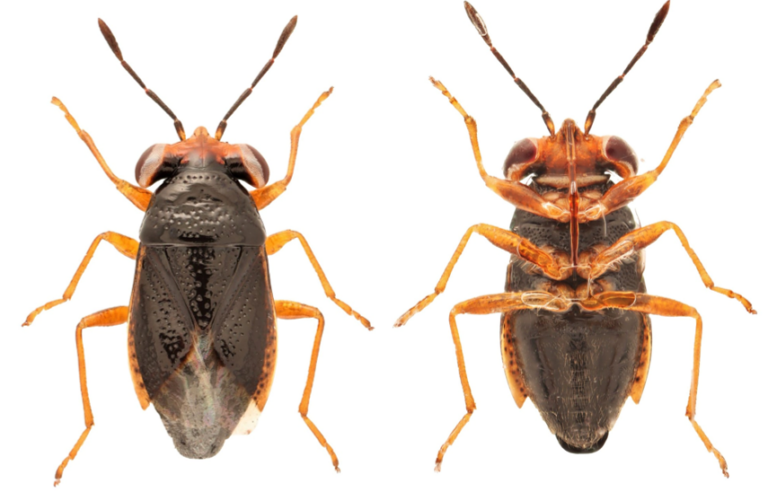
As part of an entomological inventory during the 2023 summer season, an alvar was visited several times in the municipality of St-Bernard-de-Lacolle (MRC des Jardins de Napierville), a site known as the "alvar de Roxham" (Fig. 1). During active hunting sessions in the low plants of the site, a dark bug with a broad head typical of Geocoridae was quickly noticed, and differed from the usual Geocoris spp. encountered at this site. Being outside the groups of interest of the current project, only one specimen was captured and preserved. Microscopic examination confirmed that it was a different species from those previously known in Quebec.
After investigation, this specimen was found to belong to the species Isthmocoris piceus (Say, 1831), an identity that was quickly confirmed by Jean-François Roch (Quebec Hemiptera specialist), as was its status as a new provincial record. The specimen was deposited in the author's personal collection (NBC) in Quebec City. A second specimen was subsequently captured by Ludovic Leclerc in a nearby locality, while sweeping various plants at the edge of forest environments. This second locality strongly suggests the established presence of this species in the south of the province. This specimen is in Ludovic Leclerc's personal collection in Quebec City (LLC).
The Geocoridae are easily distinguished from other hemipteran families by their very typical head shape. Some members of other families (e.g. Phlegyas spp.: Pachygronthidae) have a similar head shape, but only Geocoridae have large, reniform eyes reaching the lateral borders of the pronotum (Kóbor, 2020). Within this family, the genus Isthmocoris can be separated from the sole other North American genus, Geocoris, by the relative size of the rostrum segments. In the genus Geocoris, the second rostrum article is shorter than the third, whereas in Isthmocoris, its the opposite (Henry et al., 2015; Kóbor, 2020). Isthmocoris piceus (Fig. 2) is easily identified by the very characteristic shape of the head (strongly transverse), by the position of the ocelli (halfway between the middle of the vertex and the margin of the eyes), as well as the uniformly black coloration except for the vertex and the front of the head, which are bright red (Readio & Sweet, 1982; Scudder, 1985) (Fig. 3). It cannot be confused with other species in Quebec.
The Geocoridae family (previously included in the Lygaeidae) is small, with around 30 species in 2 genera in North America (Delapé and Henry 2024). In Quebec, only 4 species were known, all belonging to the genus Geocoris (Roch, 2020). The discovery of I. piceus increases the number of species in Quebec to 5, in 2 genera (Geocoris and Isthmocoris). Isthmocoris piceus is a widespread species in northeastern North America. It has been known from Ontario since 1985, following examination of a specimen captured in 1958 (Scudder, 1985), and from New York, Vermont, New Hampshire and Maine (Roch, 2020), as well as Massachusetts, Pennsylvania, Delaware, Illinois, Iowa, Kentucky, Wisconsin (BugGuide , 2024), Michigan and Indiana (INaturalist 2024). Its discovery in Quebec therefore comes as no great surprise, as its presence was already known in most of the neighboring territories. A specimen on the INaturalist site was also observed in the City of Ottawa, not far from the Ontario-Quebec border, indicating the species is potentially present in this area too.
Geocoridae are primarily predators of other arthropods, and are frequently studied for their impacts on various insect pests (e.g. Davis, 1981; Asa and Watson, 1982; Hutchison and Pitre, 1983; Eubanks and Denno, 1999; Olson et al., 2018). However, it is common to observe individuals feeding on plants, mainly for hydration purposes (Naranjo and Stimac, 1985).
Thanks to Jean-François Roch for confirming the identification, and to Ludovic Leclerc for sharing his capture data.
Ali ASA, and Watson TF (1982) Efficacy of dipel and Geocoris punctipes (Hemiptera: Lygaeidae) against the tobacco budworm (Lepidoptera: Noctuidae) on cotton. Journal of Economic Entomology 75: 1002–1004. https://doi.org/10.1093/jee/75.6.1002
BugGuide (2024). Species Isthmocoris piceus, Data. [14-02-2024].
Davis DL (1981) Population dynamics of four species of Geocoris in the peanut agroecosystem. PhD dissertation, Texas A&M Libraries. 151 pp.
Dellapé PM and Henry TJ (2024) Lygaeoidea Species File. Version 5.0/5.0. [14-02-2024].
Eubanks MD and Denno RF (1999) The ecological consequences of variation in plants and prey for an omnivorous insect. Ecology 80(4): 1253-1266. https://doi.org/10.1890/0012-9658(1999)080[1253:TECOVI]2.0.CO;2
Henry TJ, Dellapé PM, de Paula AS (2015) The big-eyed bugs, chinch bugs, and seed bugs (Lygaeoidea). In: Panizzi, A., Grazia, J. (eds) True Bugs (Heteroptera) of the Neotropics. Entomology in Focus, vol 2. Springer, Dordrecht. https://doi.org/10.1007/978-94-017-9861-7_16
Hutchison WD and Pitre HN (1983) Predation of Heliothis virescens (Lepidoptera: Noctuidae) eggs by Geocoris punctipes (Hemiptera: Lygaeidae) adults on cotton. Environmental Entomology 12(6), 1652-1656. https://doi.org/10.1093/ee/12.6.1652
INaturalist (2024). Isthmocoris piceus. [14-02-2024].
Kóbor P (2020) Investigations on the taxonomy and systematics of big-eyed bugs (Heteroptera: Lygaeoidea: Geocoridae). Doctoral dissertation, Pannon Egyetem. 93 pp. https://doi.org/10.18136/PE.2020.749
Naranjo SE, and Stimac JL (1985) Development, survival, and reproduction of Geocoris punctipes (Hemiptera: Lygaeidae): effects of plant feeding on soybean and associated weeds. Environmental Entomology 14(1): 523–530. https://doi.org/10.1093/ee/14.4.523
Olson DM, Zeilinger AR, Prescott KK, Coffin AW, Ruberson JR, and Andow DA (2018) Landscape effects on Solenopsis invicta (Hymenoptera: Formicidae) and Geocoris spp.(Hemiptera: Geocoridae), two important omnivorous arthropod taxa in field crops. Environmental Entomology 47(5): 1057-1063. https://doi.org/10.1093/ee/nvy104
Readio J and Sweet MH (1982) A review of the Geocorinae of the United States east of the 100th meridian (Hemiptera: Lygaeidae). Miscellaneous Publications of the Entomological Society of America 13 (3) : 1-91. https://doi.org/10.4182/KZTK4730
Roch JF (2020) Liste des Punaises du Québec et des Régions Adjacentes (Hemiptera: Heteroptera). Document Faunique 27. Version 2.3. Entomofaune du Québec Inc., Saguenay, 41 pp.
Say T (1831) Description of new species of heteropterous Hemiptera of North America. New Harmony, Indiana. 39 pp.
Scudder GGE (1985). Heteroptera new to Canada. Journal of the Entomological Society of British Columbia, 82, 66-71.

Fig. 1. Photograph of the capture habitat of the Isthmocoris piceus (Say, 1832) specimen in the Roxham alvar. An alvar is a natural limestone outcrop, and is a type of environment known to harbor exceptional diversity (Conservation Nature Canada, 2023).

Fig. 2. Habitus of a specimen of Isthmocoris piceus (Say, 1832) (NBCCH230829).

Fig. 3. Comparison of the head shape of the Isthmocoris genus (left) and the Geocoris genus (right).